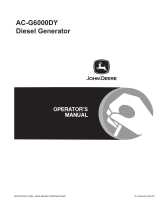
2 Operator’s Manual for Portable Generator
• For safety reasons, it is recommended that
the maintenance of this equipment be per-
formed by an Authorized Service Facility.
Inspect the generator regularly, and contact
the nearest Authorized Dealer for parts
needing repair or replacement.
• Operate generator only on level surfaces
and where it will not be exposed to exces-
sive moisture, dirt, dust or corrosive vapors.
• When working on this equipment, remain
alert at all times.
• Never work on the equipment when physi-
cally or mentally fatigued.
• Never use the generator or any of its parts
as a step. Stepping on the unit can stress
and break parts, and may result in danger-
ous operating conditions from leaking
exhaust gases, fuel leakage, oil leakage,
etc.
Exhaust and Location Hazards
• This exhaust system must be properly
maintained. Do nothing that might render
the exhaust system unsafe or in noncompli-
ance with any local codes and/or stan-
dards.
• If you start to feel sick, dizzy, or weak after
the generator has been running, move to
fresh air IMMEDIATELY. See a doctor, as
you could have carbon monoxide poison-
ing.
Electrical Hazards
• The National Electric Code (NEC) requires
the frame and external electrically conduc-
tive parts of the generator be properly con-
nected to an approved earth ground. Local
electrical codes may also require proper
grounding of the generator. Consult with a
local electrician for grounding requirements
in the area.
• Use a ground fault circuit interrupter in any
damp or highly conductive area (such as
metal decking or steel work).
(000116)
DANGER
Electrocution. Turn utility and emergency
power supplies to OFF before connecting power
source and load lines. Failure to do so will result
in death or serious injury.
(000111)
WARNING
Moving Parts. Keep clothing, hair, and appendages
away from moving parts. Failure to do so could
result in death or serious injury.
(000108)
WARNING
Hot Surfaces. When operting machine, do not
touch hot surfaces. Keep machine away from
combustables during use. Hot surfaces
could result in severe burns or fire.
(000146)
WARNING
Equipment and property damage. Do not alter
construction of, installation, or block ventilation for
generator. Failure to do so could result in unsafe
operation or damage to the generator.
(000142)
Do not insert any object through the air cooling slots.
Generator can start at any time and could result in
death, serious injury and unit damage.
WARNING
(000107)
WARNING
Hearing Loss. Hearing protection is recommended
when using this machine. Failure to wear hearing
protection could result in permanent hearing loss.
(000103)
DANGER
Asphyxiation. Running engines produce carbon
monoxide, a colorless, odorless, poisonous gas.
Carbon monoxide, if not avoided,
will result in death or serious injury.
(000146)
WARNING
Equipment and property damage. Do not alter
construction of, installation, or block ventilation for
generator. Failure to do so could result in unsafe
operation or damage to the generator.
(000178a)
Asphyxiation. Always use a battery operated carbon
monoxide alarm indoors and installed according to
the manufacturer’s instructions. Failure to do so could
result in death or serious injury.
WARNING
(000144)
DANGER
Electrocution. Contact with bare wires, terminals,
and connections while generator is running will
result in death or serious injury.
(000104)
DANGER
Electrocution. Water contact with a power source,
if not avoided, will result in death or serious injury.
(000145)
DANGER
Electrocution. In the event of electrical accident,
immediately shut power OFF. Use non-conductive
implements to free victim from live conductor. Apply
first aid and get medical help. Failure to do so will
result in death or serious injury.





















